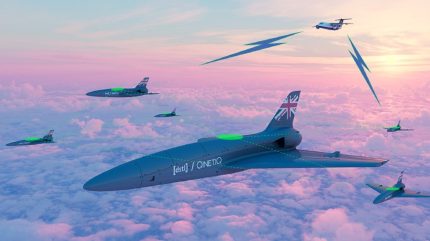
British defence supplier QinetiQ has orchestrated the UK’s first crewed-uncrewed teaming exercise between a jet and a swarm of autonomous aerial systems.
The trial – which took place in collaboration with the Defence Science and Technology Laboratory (Dstl), the Royal Navy and the Air and Space Warfare Centre (ASWC) – saw a QinetiQ jet aircraft take off from Ministry of Defence (MOD) site Boscombe Down in Salisbury, UK, while a modified Banshee Jet 80 uncrewed aerial system (UAS) was launched from the MoD Hebrides range, off the north-west coast of Scotland.
Flying at 350 knots, the mission was completed not only by the live Banshee but also by several digital Banshees within a live virtual swarm, successfully acting in a co-ordinated manner.
Banshee was equipped with QinetiQ’s Airborne Command and Control for Swarm Interoperable Missions technology, which allows the UAS to communicate with the crewed aircraft using the same communications as the standard Nato Link 16 datalink.
This technology provides an airborne gateway that can receive and translate long-range and short-range communications between UAS. At the same time, an in-built safety system can override the autonomy to ensure the system always stays within a safe operating area.
Cultivating a hybrid force
From Europe to the UK and the US, a new concept of building a ‘hybrid’ force structure – bringing together crewed and uncrewed platforms – has come into play following the proliferation of UAS.

US Tariffs are shifting - will you react or anticipate?
Don’t let policy changes catch you off guard. Stay proactive with real-time data and expert analysis.
By GlobalDataThe US defence industry has made some strides in that regard under the auspices of the Next-Generation Air Dominance (NGAD) programme, in which the US Air Force has lately down-selected two vendors to compete to test their concept for the Collaborative Combat Aircraft – an accompanying UAS to go along with its fifth and sixth generation crewed fighter jets – in the same way as QinetiQ has demonstrated.
Likewise, the Future Combat Air System (FCAS) – pursued by France, Germany and Spain – also envisions the same teaming concept in which all their platforms are connected via a ‘Combat Cloud’.
QinetiQ is one of many industrial partners ingratiated in Team Tempest, the UK’s grouping within the British, Italian and Japanese Global Combat Air Programme (GCAP). The company is currently responsible for test and evaluation activities in this group.
However, with the success of the UK’s first successful teaming trial, the supplier is on track to offer its proven services as an integrator for the GCAP force structure.



